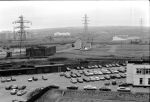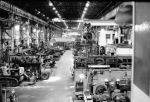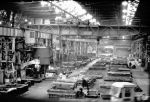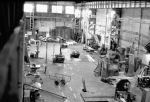MORE CHAPEL BANK.
The photographs on this page were taken in 1980, shortly before closure of the
foundry was announced. The foundry end of Chapel Bank was
demolished in 1982. The old Drawing-offices were turned into the British Cattle Movement Centre,
where animal passports and associated administration is handled.
NOTE:The small images are clickable links to larger versions!
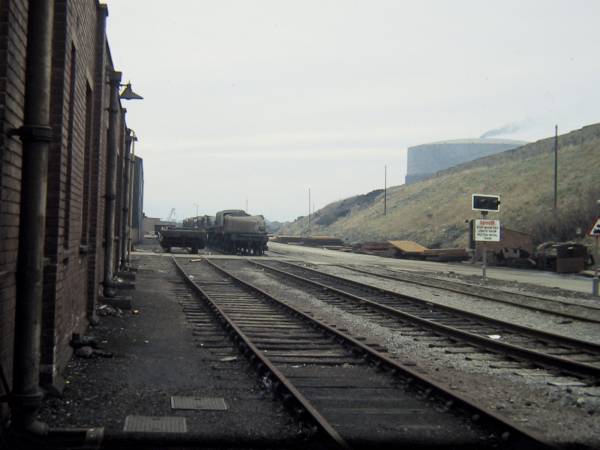 RIGHT: The view towards Moss-Bay from the back door of the
fabrication shop electrical sub-station. The notice tells road-vehicles to stop and give way to
trains carrying hot-metal (in "torpedo cars"), and was somewhat previous in erection,
as the whole planned transportation of hot metal from the blast-furnaces to Chapel Bank went
pear-shaped in 1980, and it never happened.
RIGHT: The view towards Moss-Bay from the back door of the
fabrication shop electrical sub-station. The notice tells road-vehicles to stop and give way to
trains carrying hot-metal (in "torpedo cars"), and was somewhat previous in erection,
as the whole planned transportation of hot metal from the blast-furnaces to Chapel Bank went
pear-shaped in 1980, and it never happened.
This page would have been equally suitable for inclusion in my
Defence Architecture
pages, given the history of the place. Construction of this special
wartime steel-making project - supposedly out of range of enemy aircraft - started in February
1941, and the first steel was made in June 1942. This "Electric Steel" was used in the
manufacture of ball and roller bearings to replace those previously obtained
from Norway (and due to enemy occupation of that land, unobtainable). The USA contributed
special steel for a while, until re-armament begun and the steel was needed
there. "U"-boat action in the Atlantic made this a near-impossible proposition anyway.
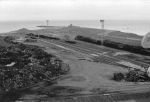 The photo (left) shows the shore as viewed from the site of the old Isabella Pit. Not quite landscaped, but on the way. The rail sidings remain, and an industrial-type lunar landscape consisting of foundry-waste is still piled up on the left-hand side. The mound to the left of the pier is the remains of the old coast-guard look-out.
The photo (left) shows the shore as viewed from the site of the old Isabella Pit. Not quite landscaped, but on the way. The rail sidings remain, and an industrial-type lunar landscape consisting of foundry-waste is still piled up on the left-hand side. The mound to the left of the pier is the remains of the old coast-guard look-out.
There were seven electric furnaces built in all at Workington (One was built concomitantly
at Moss Bay, adjacent to the Bessemer plant), but only five of the six
at Chapel Bank were used. Each furnace was of 20 tons capacity, and all were managed by the
United Steel Company on behalf of the Ministry of Supply. The electrical load of these
furnaces were such that a new supply-line was constructed to feed electricity to them from the
recently built power-station at Willowholme, Carlisle. 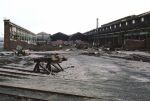
RIGHT: The end - literally! - of the foundry, bays 6, 5 and 4. Taken in either early 1984 or late 1983.
Towards the end of 1944, the special steel-making facility was wound up. The furnaces were sold -
to steel plants in Sweden and South Africa 1n 1945. The "A1" furnace at the Bessemer
plant was not sold, but operated satisfactorily for about 30 years afterwards. Chapel Bank was converted in 1946 to the foundry/machine-shop/fabrication shop (as I remember it), and skilled workers were recruited from other parts of the UK. Many people came from Clydeside, Newcastle,
Belfast and the Midlands to settle into the new homes built by the Westfield Housing Association.
Managerial-type dwellings were constructed on Eldred Road, at the top of the town.
Below are a selection of pictures of the works taken in 1979/80.
From the left:
- The view over the car-park and bowling green (yes, Chapel Bank had a bowling-green!) to the electricity sub-station and works railway signal-box (outside the perimeter wall).
- The foundry maintenance bay 1, from the electricians' workshop end.
- The foundry, bay 5, with electric overhead travelling crane.
- The pattern-shop.
The "Distington" connection in the naming of this plant was a wartime
deception. Initially given the name of "The Distington Haematite Iron Company",
the only connection with the village of Distington - five
miles away - was that the ornate gates on Chapel Bank's main entrance came from Distington
Hall. The plant was later retitled the "Distington Engineering Company, ltd".
Chapel Bank was one of the control points for the town's air-raid sirens. It was operated
from a small room to the right-hand side of the main entrance foyer where the master-clock and
time-signalling equipment was kept. On the wall was mounted a small black motor starter, with
the legends "Red Alert" and "Raiders Passed" clearly visible adjacent
to the red and green buttons. This box operated the huge motor-driven siren which was mounted
on the roof at the front of the machine-shop end. It was removed by a Government department
in the late 1980's.
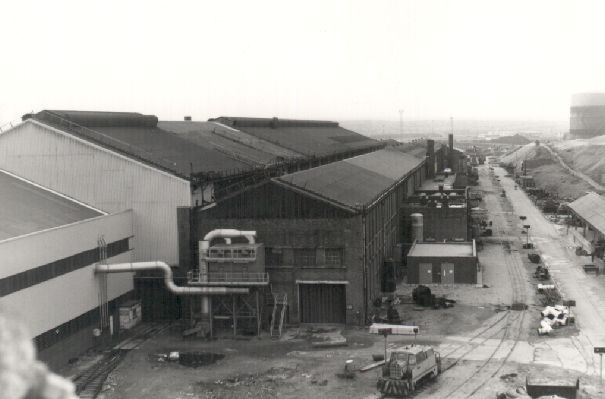
The above shows the outside of
the pattern shop, looking South-West down bay 1, the foundry
maintenance bay.
Below:
Another E.O.T crane, this time outside, on the site of what was
the old Williamson's Shipyard. The adjacent building was used as
a store. I remember clambering up on to this crane one snowy winter's day to
repair the lifting-magnet connections which had come adrift; What
fun......
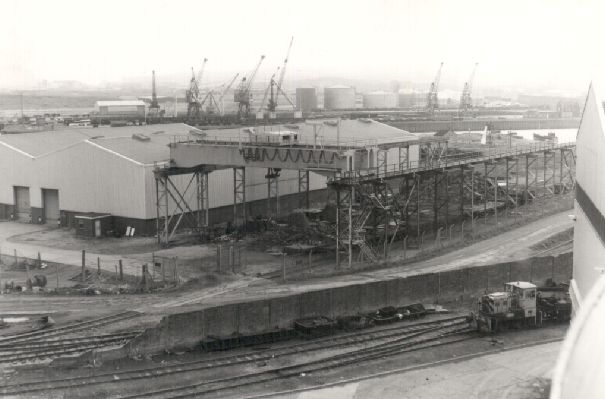
If this page has tickled your fancy, have a look at the other Chapel Bank pages by
clicking here for some Chapel Bank people, or here for the main Chapel Bank
page.
Home | Contents |
Defence Architecture | Links |
E-Mail

 RIGHT: The view towards Moss-Bay from the back door of the
fabrication shop electrical sub-station. The notice tells road-vehicles to stop and give way to
trains carrying hot-metal (in "torpedo cars"), and was somewhat previous in erection,
as the whole planned transportation of hot metal from the blast-furnaces to Chapel Bank went
pear-shaped in 1980, and it never happened.
RIGHT: The view towards Moss-Bay from the back door of the
fabrication shop electrical sub-station. The notice tells road-vehicles to stop and give way to
trains carrying hot-metal (in "torpedo cars"), and was somewhat previous in erection,
as the whole planned transportation of hot metal from the blast-furnaces to Chapel Bank went
pear-shaped in 1980, and it never happened.

